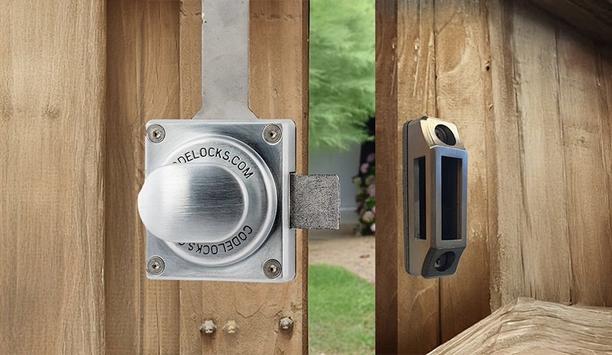Codelocks Ltd - Experts & Thought Leaders
Latest Codelocks Ltd news & announcements
Codelocks is expanding its Gate Solutions by Codelocks range with the introduction of the new Codelocks’ Surface Latch. This highly versatile self-locking, surface mount latch is designed for effortless installation on light-duty gates where traditional mortice latches are not an option. Codelocks’ new Surface Latch Jo Milne-Rowe, Managing Director at Codelocks said: “Protecting perimeters and outdoor areas is becoming a pressing concern for householders and businesses. In Codelocks’ new Surface Latch, we have developed a simple-to-install, self-locking system that provides reliable access control for external gates with low to medium traffic." "These are gates that don’t require heavier access control solutions. Typical uses include side gates into shared residential gardens or utility areas, private parking areas and driveways, up to small industrial or agricultural facilities.” Codelocks’ mechanical and electronic ranges The Surface Latch has a simple, surface mount installation and is non-handed The Surface Latch has a simple, surface mount installation and is non-handed, making it suitable for left- and right-handed and in-swing gates of between 35mm to 60mm thickness. It also works seamlessly with locks from Codelocks’ mechanical and electronic ranges, giving customers the reassurance of Codelocks’ high-performance and reliability. Gate Solutions by Codelocks range of products Codelocks’ Surface Latch comes in two finishes; Marine Grade black and Brushed Steel giving it an unobtrusive look and suitability for a range of external applications. Part of the comprehensive Gate Solutions by Codelocks range of products, that are designed to protect perimeters and outdoor areas with easy-to-use, Surface Latch offers effective access control that is perfect for residential and commercial settings.
Codelocks has appointed Nayem Momin as its new Area Sales Manager for the South of England. Nayem has over six years’ experience in and sales, including three years in the door hardware sector. He brings a wealth of experience in expanding customer bases and fostering long-term relationships. Codelocks’ customer base Notably, Nayem was previously responsible for the master key systems of the apartments in the redeveloped Battersea Power Station as well as push button locks for the retail section within the development. Nayem will apply his strengths in developing and implementing strategic sales plans to grow Codelocks’ customer base and solidify its presence as a pioneer in architectural ironmongery across the South of England. Reputation for innovation and reliability Nayem will apply his strengths in developing and implementing strategic sales plans Joanne Milne-Rowe, Codelocks’ Managing Director UK commented on the new appointment, saying, “With three decades of providing world-class access control solutions, Codelocks continues to evolve and strengthen our market position. Nayem is a hugely welcome addition to our growing team." "His appointment reflects our commitment to strategic growth and our deep understanding of customer needs in the South of England. His expertise will help us build on our reputation for innovation and reliability, ensuring we continue to lead the way in mechanical and electronic lock technologies.” Innovation and development in access control Newly appointed Area Sales Manager for the South of England, Nayem Momin said, “Joining the Codelocks’ team and helping its continued growth is a great proposition for anyone interested in innovation and development in access control." "What excites me most is seeing how our products make life easier for people and give them peace of mind that places and property are protected in an intelligent, streamlined fashion. It’s an inspiring company to be part of, in an important industry sector.”
Codelocks is taking its free expert training on the road early in 2025, starting in Rugby, Warwickshire, on Thursday, 13th February. The training session is on Mastering Electronic Lock Installation for Timber Fire Doors and features the practical installation of Codelocks’ CL5010 Lock and FireKit in the Master Locksmith’s Association's superb training lab. Latest developments in CE Marking Attendees will also receive valuable updates on the latest developments in CE Marking and FireKits as well as insight into Codelocks’ Mechanical and Electronic Ranges. Codelocks ‘On the Road Locks' training has been running across the UK for over two years. The tailored, hands-on, practical troubleshooting sessions have been very well received by distributors, locksmiths and installers. Importance of installing electronic locks Michelle Saunders, Sales Manager, at Codelocks explains, “Our first On the Road Locks training of 2025 is a very timely session on the importance of installing electronic locks on timber fire doors. Fire safety is a major concern and it’s vital that electronic locks are installed correctly to protect people and prevent the spread of fire." "Our free training courses are always very popular, especially the practical sessions and the fact that our experts are on hand to answer any questions about Codelocks’ ranges.”
Insights & Opinions from thought leaders at Codelocks Ltd
As the vaccine roll-out proceeds, people across the UK are counting the days until we can get back to some kind of ‘new normal’. Just as we’ve seen in education and healthcare, the return to the workplace and other public spaces will be accompanied by enhanced sanitisation and social distancing measures. To make the return as swift and safe as possible, those of us involved with managing, building and constructing buildings should consider how we can help facilitate and support those measures. Regardless of how rigorously we impose social distancing measures, there will always be some areas where we can’t help coming into contact with each other. Sanitising door handles Doors, for example – and door locks and handles in particular – are shared by nearly everyone in a building. Even in large, open spaces, we all need to pass through a single entrance. We all use the same door handles and locks – and they provide ideal surfaces for bacteria to breed and transfer. Another solution is for staff to regularly sanitise door handles and locks One solution to this problem is to provide hand-sanitiser dispensers at each door and insist on their use. But this can be difficult to manage in larger buildings where there may be multiple doors and entrances used by both staff and visitors. People could ignore the sanitisation rules too. Another solution is for staff to regularly sanitise door handles and locks – but this is a resource intensive option and, again, is dependent on everyone maintaining good practice. Potentially harmful chemicals A longer-lasting way to deal with the risk of locks and door handles spreading disease is to treat them with an anti-viral coating. These coatings come in various forms. Some, for example, slowly release anti-bacterial chemicals, while others have antiviral properties actually built into the material or the coating. Those coatings with built-in antiviral properties tend to be longer-lasting and more effective, and also avoid the issue of releasing potentially harmful chemicals into the environment. A number of different solutions with built-in protection are currently in development, and some already available. Northumbria University, for example (as reported in last Month’s PSB Magazine), is working on a ‘super-hydrophobic’ coating for use on high-contact areas such as handrails and trolleys. Optional antiviral coating Codelocks is working on a coating that attaches biocides to nanoparticles Another British company, Smart Separations, is working on a coating that attaches biocides to nanoparticles, and can be applied to a wide variety of surfaces. While these anti-viral coatings are either still in development or only available to large corporate clients, others are already readily available. Access control solutions provider Codelocks, for example is currently offering an optional antiviral coating with all of its products. Clean by Codelocks is clear coating that uses nanotechnology that can kill bacteria in a matter of minutes. Clean by Codelocks utilises a process called photocatalytic oxidation. The surface of the coating reacts with light and converts harmful bacteria and germs into a non-toxic compound, resulting in a clean and hygienic surface. Chemical cleaning products The coating has been proven to eliminate the SARS-CoV-2 coronavirus (COVID-19) from surfaces within minutes and is resistant to chemical cleaning products, humidity, and UV exposure – all issues that can cause problems for traditional slow-release type coatings. It’s been said that COVID-19 has been a great technology accelerator. This has been proven true, not only in the areas of vaccine research and development, or in cloud and digital technology but even in everyday objects that we take for granted such as locks and door handles. By building anti-bacterial protection into access control solutions, we can make schools, surgeries, workplaces, leisure centres and other public spaces safer for all.
A defibrillator can save the life of a person suffering from cardiac arrest – but it is most effective when used in the first few minutes of the patient collapsing. Studies have shown that a shock given within the first three minutes provides the best chance of survival and even one minute of further delay can substantially lower the chances of recovering. Public Access Defibrillators (PADs) were created to allow untrained members of the public to deliver life-saving treatment in those precious minutes before an ambulance arrives. There are currently over 10,000 in the UK, located in parks, offices, high streets and sporting venues, and they are especially popular in rural communities, where ambulance response times are longer. Every second counts Over the years there has been a long-running debate as to whether PADs should be kept openly accessible or locked. Leaving them open could lead to theft, vandalism or misuse. Leaving them locked could mean that precious moments are lost waiting for a local guardian to arrive – and could even cost a life. To save as many lives as possible, it’s clear that PADs need to be available 24/7, fully operational and easily accessible to users and local guardians. But there is a solution that can meet all these conditions – a lock that can protect against vandalism while providing convenient instant access when required. Life-saving solutions Over the years there has been a long-running debate as to whether PADs should be kept openly accessible or lockedDigital locks are ideal for securing PADs because they don’t require a key, and anyone can be given access over the phone. In the case of a cardiac arrest, the user calls 999 and the ambulance controller provides them with a simple, easy-to-remember code. The ambulance controller can then advise them, step by step, what to do. Local guardians, who have responsibility for the PAD, can be provided with an override key to enable them to monitor and maintain the defibrillator. The PAD cabinets built by Duchy Defibrillators show exactly how this works in practice. Based in rural Cornwall, Duchy Defibrillators manufactures, supplies and installs monitored PAD cabinets. To provide public access to the defibrillators, it needed a lock that could keep its cabinets secure, make them easily accessible and withstand the stormy Cornish weather. Codelocks recommended a digital electronic lock that could operate on a standalone battery, making it especially suitable for remote areas. As well as offering flexible access, digital locks come with a range of varying options and functions to suit different applications. As Duchy Defibrillator cabinets are installed in a wide variety of locations and sometimes need to withstand outdoor exposure, it opted for a robust electronic digital lock that is both affordable and easy to set up. A digital-access revolution Using smart locks in combination with a dedicated app or portal allows operators to send time-sensitive codes to end-users The example of Duchy Defibrillators shows how digital locks can be used to keep defibrillator cabinets secure while affording instant access to users when they are needed. But the flexibility of digital locks also makes them suitable for securing property and equipment in a wide variety of situations, especially for shared and public facilities. This is why you’ll increasingly see digital locks used to secure restricted areas in hospitals, schools and offices, as well as shared facilities like hotel and gym lockers, public restrooms and more. Digital locks are available for a number of specific applications, including doors, lockers and cabinets. They can range from simple mechanical locks through to more sophisticated electronic locks and state-of-the-art smart locks. Using smart locks in combination with a dedicated app or portal allows operators to send time-sensitive codes to end users – making them very popular for contactless entry and with facilities managers that need to manage access to buildings and campuses. One thing is certain – whatever your access control requirements are, there’s a keyless lock solution to suit. The digital access revolution is here.
Using artificial intelligence (AI) to automate physical security systems
DownloadA modern guide to data loss prevention
Download7 proven solutions for law enforcement key control and asset management
DownloadThe truth behind 9 mobile access myths
DownloadAccess control system planning phase 2
Download























